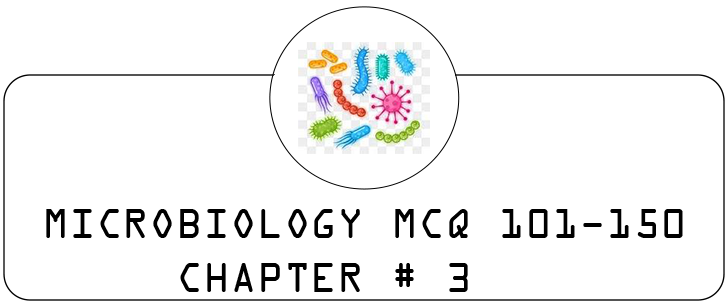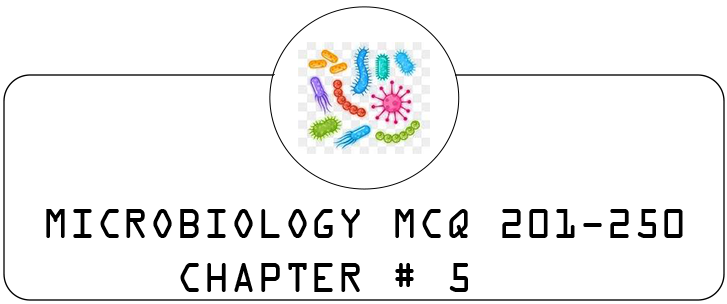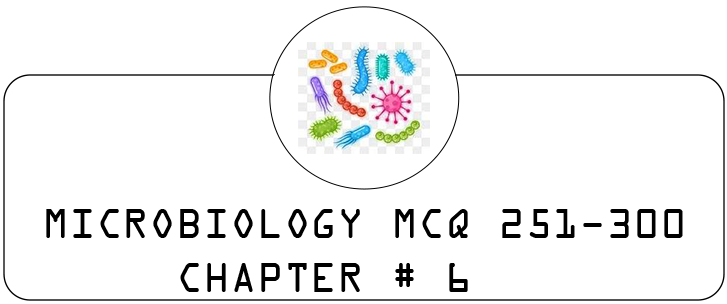
51. Which one is NOT protective mechanism of body:
A. Fever
B. Necrosis ✅
C. Phagocytosis
D. Inflammation
A. Fever
B. Necrosis ✅
C. Phagocytosis
D. Inflammation
52. Bioterrorism microbial agents are classified based upon:
A. Pathogenicity
B. Spread
C. Availability
D. Both “A” and “B” ✅
A. Pathogenicity
B. Spread
C. Availability
D. Both “A” and “B” ✅
53. Which one of the following immunoglobulins can cross the blood placental barrier?
A. Ig G ✅
B. Ig M
C. Ig A
D. Ig D
A. Ig G ✅
B. Ig M
C. Ig A
D. Ig D
54. Hematopoietic stem cells are precursor cells for all of the following EXCEPT:
A. Lymphocytes
B. Monocytes
C. Erythrocytes
D. Vascular smooth muscle cells ✅
A. Lymphocytes
B. Monocytes
C. Erythrocytes
D. Vascular smooth muscle cells ✅
55. Macrophages present in liver are called:
A. Microglial cells
B. Alveolar macrophages
C. Kupffer cells ✅
D. Wondering macrophages
A. Microglial cells
B. Alveolar macrophages
C. Kupffer cells ✅
D. Wondering macrophages
56. Antibiotic penicillin was introduced by:
A. Pasteur
B. Fleming ✅
C. Jenner
D. Lister
A. Pasteur
B. Fleming ✅
C. Jenner
D. Lister
57. Prokaryotic cell lacks:
A. DNA
B. Ribosomes
C. Mitochondria ✅
D. Plasma membrane
A. DNA
B. Ribosomes
C. Mitochondria ✅
D. Plasma membrane
58. Immunity against yellow fever in newborn is an example of:
A. Active naturally acquired
B. Passive artificially acquired
C. Passive naturally acquired ✅
D. Artificial immunity
A. Active naturally acquired
B. Passive artificially acquired
C. Passive naturally acquired ✅
D. Artificial immunity
59. All structures are external to cell wall EXCEPT:
A. Glycocalyx
B. Flagella
C. Pilli
D. Spores ✅
A. Glycocalyx
B. Flagella
C. Pilli
D. Spores ✅
60. A typical bacterial cell has only _____ volume of a typical eukaryotic cell.
A. 1/10 ✅
B. 1/100
C. 1/1000
D. 1/10000
A. 1/10 ✅
B. 1/100
C. 1/1000
D. 1/10000
61. PCR reaction includes all, EXCEPT:
A. DNA ligase ✅
B. Four dNTPs
C. DNA template
D. DNA polymerase
A. DNA ligase ✅
B. Four dNTPs
C. DNA template
D. DNA polymerase
62. If disease is endemic, prevalence equals to:
A. C x I
B. I x D ✅
C. P x D
D. C x D
A. C x I
B. I x D ✅
C. P x D
D. C x D
63. Southern hybridization is used to identify:
A. A specific protein
B. A specific RNA sequence
C. A specific DNA sequence ✅
D. Both “A” and “B”
A. A specific protein
B. A specific RNA sequence
C. A specific DNA sequence ✅
D. Both “A” and “B”
64. All of the following bacteria are members of family Enterobacteriaceae EXCEPT:
A. E. coli
B. Shigella
C. Staphylococcus ✅
D. Salmonella
A. E. coli
B. Shigella
C. Staphylococcus ✅
D. Salmonella
65. A library of DNA fragments results from the use of:
A. Viruses
B. Restriction endonucleases ✅
C. DNA ligases
D. Plasmids
A. Viruses
B. Restriction endonucleases ✅
C. DNA ligases
D. Plasmids
66. Swarming growth is the characteristic of Gram-negative bacteria known as:
A. Clostridium
B. Proteus ✅
C. Pasteurella
D. Pseudomonas
A. Clostridium
B. Proteus ✅
C. Pasteurella
D. Pseudomonas
67. Mesophilic bacteria CANNOT grow at temperature:
A. 16°C
B. 25°C
C. 35°C
D. 38°C ✅
A. 16°C
B. 25°C
C. 35°C
D. 38°C ✅
68. Facultative anaerobic bacteria grow in presence of:
A. Only O2
B. O2 and also CO2 ✅
C. Only CO2
D. N2
A. Only O2
B. O2 and also CO2 ✅
C. Only CO2
D. N2
69. Mannitol salt agar is an example of:
A. Selective medium
B. Differential medium
C. Both “A” and “B” ✅
D. Enrichment medium
A. Selective medium
B. Differential medium
C. Both “A” and “B” ✅
D. Enrichment medium
70. Translation occurs in:
A. Nucleus
B. Cytoplasm
C. Ribosomes ✅
A. Nucleus
B. Cytoplasm
C. Ribosomes ✅
71. Aflatoxin is produced by:
A. Candida
B. Aspergillus flavus ✅
C. Penicillium
D. Clostridium
A. Candida
B. Aspergillus flavus ✅
C. Penicillium
D. Clostridium
72. HIV infects most commonly:
A. CD4+ cells ✅
B. CD8+ cells
C. B-lymphocytes
D. Basophils
A. CD4+ cells ✅
B. CD8+ cells
C. B-lymphocytes
D. Basophils
73. Toxoplasma gondii is spread by:
A. Dog
B. Cat ✅
C. Human
D. Sheep
A. Dog
B. Cat ✅
C. Human
D. Sheep
74. Cell-mediated immunity is mainly carried out by:
A. T cells ✅
B. B cells
C. Macrophages
D. Monocytes
A. T cells ✅
B. B cells
C. Macrophages
D. Monocytes
75. Vaccination is based on the principle of:
A. Agglutination
B. Phagocytosis
C. Immunological memory ✅
D. Clonal deletion
A. Agglutination
B. Phagocytosis
C. Immunological memory ✅
D. Clonal deletion
76. Reaction of soluble antigen with antibody is _______:
A. Agglutination
B. Precipitation ✅
C. Flocculation
D. CFT
A. Agglutination
B. Precipitation ✅
C. Flocculation
D. CFT
77. Preliminary screening can be done by:
A. restriction enzyme
B. dyes
C. antibiotics ✅
D. radiation
A. restriction enzyme
B. dyes
C. antibiotics ✅
D. radiation
78. All of these are antigen presenting cells EXCEPT:
A. T cells ✅
B. B cells
C. Dendritic cells
D. Langerhans cells
A. T cells ✅
B. B cells
C. Dendritic cells
D. Langerhans cells
79. Which of the following is not included in intrinsic determinants of a disease?
A. Specie ✅
B. Environment
C. Genetics
D. Both “A” and “B”
A. Specie ✅
B. Environment
C. Genetics
D. Both “A” and “B”
80. Which of the following substance can only induce immune response after binding to a larger molecule?
A. Antigen
B. Virus
C. Hapten ✅
D. Antibody
A. Antigen
B. Virus
C. Hapten ✅
D. Antibody
81. Immunoglobulin which can cross placenta is:
A. Ig A
B. Ig M
C. Ig D
D. Ig G ✅
A. Ig A
B. Ig M
C. Ig D
D. Ig G ✅
82. Gram-negative bacteria are resistant to:
A. Penicillin
B. Lysozyme ✅
C. Vancomycin
D. All of the above
A. Penicillin
B. Lysozyme ✅
C. Vancomycin
D. All of the above
83. The most potent known immunogenic agent is:
A. Lipids
B. Polysaccharides
C. Proteins ✅
D. Nucleic acids
A. Lipids
B. Polysaccharides
C. Proteins ✅
D. Nucleic acids
84. Neutrophils primarily respond to:
A. Viral infections
B. Parasitic infections
C. Bacterial infections ✅
D. Fungal infections
A. Viral infections
B. Parasitic infections
C. Bacterial infections ✅
D. Fungal infections
85. The term 'antigenic drift' refers to:
A. Major changes in antigenic properties
B. Minor changes in antigenic properties ✅
C. Genetic reassortment
D. Antibody enhancement
A. Major changes in antigenic properties
B. Minor changes in antigenic properties ✅
C. Genetic reassortment
D. Antibody enhancement
86. Bacteria that can cause gas gangrene is:
A. Clostridium perfringens ✅
B. Streptococcus pyogenes
C. Staphylococcus aureus
D. Escherichia coli
A. Clostridium perfringens ✅
B. Streptococcus pyogenes
C. Staphylococcus aureus
D. Escherichia coli
87. Which organism is commonly associated with food poisoning due to improper canning?
A. Salmonella
B. Clostridium botulinum ✅
C. Escherichia coli
D. Staphylococcus aureus
A. Salmonella
B. Clostridium botulinum ✅
C. Escherichia coli
D. Staphylococcus aureus
88. The most effective method for sterilizing heat-sensitive equipment is:
A. Dry heat sterilization
B. Moist heat sterilization ✅
C. Ethylene oxide sterilization
D. Gamma radiation
A. Dry heat sterilization
B. Moist heat sterilization ✅
C. Ethylene oxide sterilization
D. Gamma radiation
89. The enzyme responsible for the destruction of bacterial cell wall is:
A. Lysozyme ✅
B. Amylase
C. Protease
D. Lipase
A. Lysozyme ✅
B. Amylase
C. Protease
D. Lipase
90. Which of the following bacteria is known for forming endospores?
A. Bacillus ✅
B. Escherichia
C. Staphylococcus
D. Streptococcus
A. Bacillus ✅
B. Escherichia
C. Staphylococcus
D. Streptococcus
91. The most common cause of bacterial meningitis in adults is:
A. Neisseria meningitidis
B. Streptococcus pneumoniae ✅
C. Listeria monocytogenes
D. Haemophilus influenzae
A. Neisseria meningitidis
B. Streptococcus pneumoniae ✅
C. Listeria monocytogenes
D. Haemophilus influenzae
92. In microbiological terms, the term 'aseptic' refers to:
A. Free of pathogens ✅
B. Free of all microorganisms
C. Sterilized environment
D. All of the above
A. Free of pathogens ✅
B. Free of all microorganisms
C. Sterilized environment
D. All of the above
93. The causative agent of syphilis is:
A. Treponema pallidum ✅
B. Neisseria gonorrhoeae
C. Chlamydia trachomatis
D. Mycoplasma
A. Treponema pallidum ✅
B. Neisseria gonorrhoeae
C. Chlamydia trachomatis
D. Mycoplasma
94. The primary cell type responsible for the antibody response is:
A. T cells
B. B cells ✅
C. NK cells
D. Macrophages
A. T cells
B. B cells ✅
C. NK cells
D. Macrophages
95. The most common viral infection in humans is:
A. Influenza
B. Rhinovirus ✅
C. Hepatitis
D. Herpes
A. Influenza
B. Rhinovirus ✅
C. Hepatitis
D. Herpes
96. Which of the following is a common virulence factor of Streptococcus pneumoniae?
A. Capsule ✅
B. Flagella
C. Pili
D. Endotoxin
A. Capsule ✅
B. Flagella
C. Pili
D. Endotoxin
97. Which one is NOT a common feature of bacterial cells?
A. Cell wall
B. Nucleus ✅
C. Plasma membrane
D. Cytoplasm
A. Cell wall
B. Nucleus ✅
C. Plasma membrane
D. Cytoplasm
98. The infection that occurs when the body’s immune system attacks its own tissues is known as:
A. Autoimmune disease ✅
B. Infectious disease
C. Congenital disease
D. None of the above
A. Autoimmune disease ✅
B. Infectious disease
C. Congenital disease
D. None of the above
99. Which of the following vaccines is live attenuated?
A. Polio (Sabin)✅
B. Polio (Salk)
C. Influenza (injected)
D. Tetanus
A. Polio (Sabin)✅
B. Polio (Salk)
C. Influenza (injected)
D. Tetanus
100. Bacteria that can survive in extreme environments are known as:
A. Mesophiles
B. Psychrophiles
C. Extremophiles ✅
D. Thermophiles
A. Mesophiles
B. Psychrophiles
C. Extremophiles ✅
D. Thermophiles





